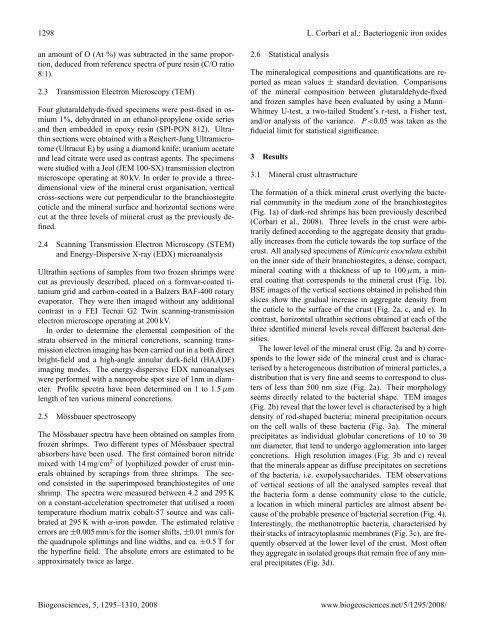View - Biogeosciences
View - Biogeosciences
View - Biogeosciences
You also want an ePaper? Increase the reach of your titles
YUMPU automatically turns print PDFs into web optimized ePapers that Google loves.
1298 L. Corbari et al.: Bacteriogenic iron oxides<br />
an amount of O (At %) was subtracted in the same proportion,<br />
deduced from reference spectra of pure resin (C/O ratio<br />
8:1).<br />
2.3 Transmission Electron Microscopy (TEM)<br />
Four glutaraldehyde-fixed specimens were post-fixed in osmium<br />
1%, dehydrated in an ethanol-propylene oxide series<br />
and then embedded in epoxy resin (SPI-PON 812). Ultrathin<br />
sections were obtained with a Reichert-Jung Ultramicrotome<br />
(Ultracut E) by using a diamond knife; uranium acetate<br />
and lead citrate were used as contrast agents. The specimens<br />
were studied with a Jeol (JEM 100-SX) transmission electron<br />
microscope operating at 80 kV. In order to provide a threedimensional<br />
view of the mineral crust organisation, vertical<br />
cross-sections were cut perpendicular to the branchiostegite<br />
cuticle and the mineral surface and horizontal sections were<br />
cut at the three levels of mineral crust as the previously defined.<br />
2.4 Scanning Transmission Electron Microscopy (STEM)<br />
and Energy-Dispersive X-ray (EDX) microanalysis<br />
Ultrathin sections of samples from two frozen shrimps were<br />
cut as previously described, placed on a formvar-coated titanium<br />
grid and carbon-coated in a Balzers BAF-400 rotary<br />
evaporator. They were then imaged without any additional<br />
contrast in a FEI Tecnai G2 Twin scanning-transmission<br />
electron microscope operating at 200 kV.<br />
In order to determine the elemental composition of the<br />
strata observed in the mineral concretions, scanning transmission<br />
electron imaging has been carried out in a both direct<br />
bright-field and a high-angle annular dark-field (HAADF)<br />
imaging modes. The energy-dispersive EDX nanoanalyses<br />
were performed with a nanoprobe spot size of 1nm in diameter.<br />
Profile spectra have been determined on 1 to 1.5 µm<br />
length of ten various mineral concretions.<br />
2.5 Mössbauer spectroscopy<br />
The Mössbauer spectra have been obtained on samples from<br />
frozen shrimps. Two different types of Mössbauer spectral<br />
absorbers have been used. The first contained boron nitride<br />
mixed with 14 mg/cm 2 of lyophilized powder of crust minerals<br />
obtained by scrapings from three shrimps. The second<br />
consisted in the superimposed branchiostegites of one<br />
shrimp. The spectra were measured between 4.2 and 295 K<br />
on a constant-acceleration spectrometer that utilised a room<br />
temperature rhodium matrix cobalt-57 source and was calibrated<br />
at 295 K with α-iron powder. The estimated relative<br />
errors are ±0.005 mm/s for the isomer shifts, ±0.01 mm/s for<br />
the quadrupole splittings and line widths, and ca. ±0.5 T for<br />
the hyperfine field. The absolute errors are estimated to be<br />
approximately twice as large.<br />
2.6 Statistical analysis<br />
The mineralogical compositions and quantifications are reported<br />
as mean values ± standard deviation. Comparisons<br />
of the mineral composition between glutaraldehyde-fixed<br />
and frozen samples have been evaluated by using a Mann–<br />
Whitney U-test, a two-tailed Student’s t-test, a Fisher test,<br />
and/or analysis of the variance. P
















